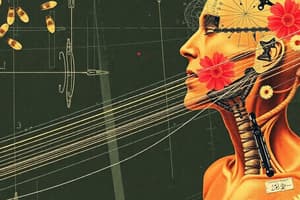Podcast
Questions and Answers
What is the primary role of ATP in muscle contraction according to the sliding filament theory?
What is the primary role of ATP in muscle contraction according to the sliding filament theory?
- To provide energy for myosin head rotation (correct)
- To enhance the bond between actin and troponin
- To initiate the release of Ca ions from the sarcoplasmic reticulum
- To decrease calcium ion concentration
What happens to calcium ions when muscle fibers depolarize?
What happens to calcium ions when muscle fibers depolarize?
- They increase in concentration in the myosin head
- They are absorbed by the actin filaments
- They bind to tropomyosin, exposing actin sites
- They are released from the sarcoplasmic reticulum into the cytosol (correct)
During muscle relaxation, what state is the myosin head in?
During muscle relaxation, what state is the myosin head in?
- It is detached from actin with ADP and inorganic phosphate bound
- It is bound to actin in a low energy state
- It is in a high energy condition, but not bound to actin (correct)
- It is hydrolyzing ATP while attached to actin
What occurs during the power stroke phase of muscle contraction?
What occurs during the power stroke phase of muscle contraction?
What is the role of the troponin-tropomyosin complex in muscle contraction?
What is the role of the troponin-tropomyosin complex in muscle contraction?
How does myosin detach from actin after the power stroke?
How does myosin detach from actin after the power stroke?
What determines the continuation of the muscle contraction cycle?
What determines the continuation of the muscle contraction cycle?
What is the significance of myosin's high energy state during muscle contraction?
What is the significance of myosin's high energy state during muscle contraction?
Flashcards
Sliding Filament Theory
Sliding Filament Theory
Muscle contraction where filaments slide past each other, not changing length.
Myosin Cross-bridges
Myosin Cross-bridges
Myosin head attachments and detachments driving the sliding filament process.
ATP Hydrolysis
ATP Hydrolysis
Breaking down ATP to release energy for myosin head movement.
Relaxed Muscle State
Relaxed Muscle State
Signup and view all the flashcards
Calcium's Role
Calcium's Role
Signup and view all the flashcards
Troponin-Tropomyosin Complex
Troponin-Tropomyosin Complex
Signup and view all the flashcards
Power Stroke
Power Stroke
Signup and view all the flashcards
Sarcomere
Sarcomere
Signup and view all the flashcards
Study Notes
Sliding Filament Theory
- The sliding filament theory is the most accepted explanation for muscle contraction
- Muscles shorten or lengthen because myofibrillar filaments slide past each other without changing length
- Myosin cross-bridges are the molecular motors driving the shortening process
- They bind, rotate, and detach from actin filaments, needing ATP hydrolysis for energy
Molecular Mechanisms of Muscle Contraction
- In the relaxed state, calcium ion concentration is low
- Actin and myosin filaments lie parallel
- Myosin heads are in a high-energy state, "cocked up," bound to ADP and inorganic phosphate
- Active sites on G-actin molecules are covered by the troponin-tropomyosin complex
Sliding Filament Theory Diagrams
- Visual representations show sarcomeres in relaxed, partially contracted, and maximally contracted states
- Diagram shows overlapping thick (myosin) and thin (actin) filaments
- The diagram displays areas including the H zone, I band, A band, and Z disc in relation to contraction
- Figures demonstrate how filaments slide past each other during contraction
Muscle Contraction Process Steps
- Action potentials in the T tubule release calcium ions from the sarcoplasmic reticulum into the cytosol
- Calcium binds to troponin, causing a conformational change reducing the troponin-actin bond
- This exposes actin's active sites, allowing the "cocked" myosin to bind (cross-bridge)
- Myosin head undergoes a conformational (ratchet) change pulling the actin filament towards the centre of the sarcomere, releasing ADP and inorganic phosphate ("power stroke")
- ATP binds to the myosin head, decreasing its affinity for actin. The myosin head detaches from the actin filament.
- ATP is hydrolyzed, recocking the myosin head and resetting it for another cycle.
- Cycling continues until calcium levels remain high
- Myosin molecules do not move simultaneously; they move sequentially, sliding along the actin filament
Energy for Muscle Contraction
- The energy source for muscle contraction is ATP
- Myosin ATPase hydrolyzes ATP, energizing cross-bridges prior to cycling
- ATP binding to myosin dissociates cross-bridges from actin, allowing the next cycle of activity
- Calcium ATPase actively transports calcium into the sarcoplasmic reticulum, ending contraction and allowing relaxation
Rigor Mortis
- This is a condition of muscles after death
- ATP is unavailable, arresting the cycle at the actomyosin complex formation
- Formation of "permanent actomyosin" complexes leads to a state of rigor
- This condition ends with denaturation of proteins
Studying That Suits You
Use AI to generate personalized quizzes and flashcards to suit your learning preferences.




